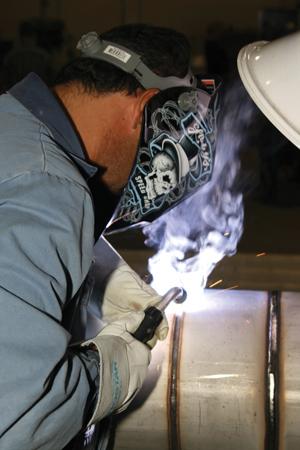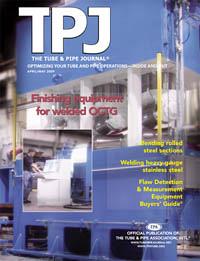- FMA
- The Fabricator
- FABTECH
- Canadian Metalworking
Categories
- Additive Manufacturing
- Aluminum Welding
- Arc Welding
- Assembly and Joining
- Automation and Robotics
- Bending and Forming
- Consumables
- Cutting and Weld Prep
- Electric Vehicles
- En Español
- Finishing
- Hydroforming
- Laser Cutting
- Laser Welding
- Machining
- Manufacturing Software
- Materials Handling
- Metals/Materials
- Oxyfuel Cutting
- Plasma Cutting
- Power Tools
- Punching and Other Holemaking
- Roll Forming
- Safety
- Sawing
- Shearing
- Shop Management
- Testing and Measuring
- Tube and Pipe Fabrication
- Tube and Pipe Production
- Waterjet Cutting
Industry Directory
Webcasts
Podcasts
FAB 40
Advertise
Subscribe
Account Login
Search
Piping in productivity on heavy-gauge stainless steel
Taking a pass on the hot pass
- By Craig Spindler
- April 1, 2009
- Article
- Arc Welding
Stainless Piping Systems Inc., Toronto, is no stranger to demanding applications. The company specializes in engineering, fabricating, and installing complete piping systems for industries such as industrial process, pharmaceutical, water treatment, food and beverage, automotive, semiconductor, and medical. It's no stranger to quality, either. Its quality control manual has been certified by the Technical Standards & Safety Authority (TSSA) in accordance with the Ontario Boilers and Pressure Vessels Act, and its welding procedures and operators are registered and certified to comply with ASME Section IX.
A quality weld isn't everything, though. In many cases, a well-documented quality weld is necessary.
"We're leading-edge when it comes to our documentation," said John Silla, co-owner. "Pharmaceutical companies, especially, want the accountability. We can produce complete documentation packages that trace all of the materials and welds."
Furthermore, the company can conduct nondestructive testing (NDT), such as radiographic examination, boroscoping, and hydrotesting, in its shop.
According to Silla, it's this combination—weld quality, documentation, and testing services—that sets SPS apart from the competition. And the competition is keen; SPS is a union shop with many nonunion, lower-cost competitors. In this environment, a small advantage can go a long way.
Schooling in Stainless
"A welder may be good at welding mild steel, but stainless is a different animal," said Silla, who has been welding since he was 13 years old. Silla, whose father also was a gas tungsten arc welder, started by welding coffee trucks and later became a pipe fitter. "I know stainless like the back of my hand," he said.
Silla sees two main problems with new welders. The first, he said, is "they can be sloppy. If you take pride in your work, you'll be a good welder. Secondly, they put too much heat into the weld. Stainless doesn't need a lot of heat. Too much heat will cause it to crystallize and lose its properties."
When teaching a new employee GTAW, Silla stresses learning to read the puddle. "I look for consistency," he explained. "If the puddle is too big, it's going to fall through. If it's too small, you won't get the penetration you need." It could take a new welder months to learn to read the puddle and achieve the SPS-quality gas tungsten arc welds, Silla said. In spite of its challenges, gas tungsten arc welding (GTAW) still has a place at SPS, especially on small-diameter (less than 8 inches) Sch. 10 pipe; but on sizes larger than that or on Sch. 40 pipe, a new modified short-circuit gas metal arc welding (GMAW) process is changing the way things are done.
A Root Substitute for GTAW
To achieve quality welds, SPS used to use GTAW for all of its pipe root passes. Other processes couldn't rival GTAW for quality and appearance, according to Silla, but a new process changed his opinion.
RMD™ (regulated metal deposition) is a modified short-circuit GMAW process from Miller Electric Mfg. Co. that anticipates and controls each short circuit, then reduces the available welding current for consistent metal transfer. RMD's controlled metal transfer provides uniform droplet deposition, creating only small ripples in the weld puddle and producing a consistent tie-in to the side wall. This, along with its ability to maintain the same arc length regardless of stick-out, makes it easier for welders, even apprentices, to control the puddle and quickly learn to create uniform, high-quality welds, Silla said.
"My welders can go right into production," said Silla. They [Miller] say an experienced welder can learn it in a day or two. It didn't take us that long. We had one experienced welder learn the process and he was immediately—I'm talking with the first joint—he was immediately productive."
In addition to the short training time, the new process had several immediate benefits for SPS. Enough metal is put down during the root pass that the welder can go right to the fill passes, eliminating the hot pass. No hot pass is required on Sch. 10, which is why the time savings are greater on the thicker pipes. The process also is tolerant of high-low fit-up; it can bridge gaps up to 3/16 in.
"There's always a high-low mismatch," said Silla. "You can't get rid of it. You just try to minimize it. It takes skill with TIG to bridge the difference. This [RMD] is so much easier."
Rotation for Automation
Rather than perform position welds, SPS prefers to rotate the pipe and keep the gun stationary, eliminating the challenge of out-of-position welding. It also saves time in three ways. First, it makes one long, continuous weld, which saves time as opposed to stopping and starting. Second, stops and starts may require the welder to grind out any porosity, which takes additional time. Third, stops are good excuses for taking a break; at union wages, that time adds up quickly.
SPS is now considering taking the ease of the process one step further.
"We tried one experiment," Silla recalled. "We mounted the MIG gun on a pipe stand, adjusted the rotation speed, and set the trigger lock. We didn't even hold the torch, and we had awesome results with that. It also lessened operator fatigue."
One Eye on the Puddle, One Eye on the Clock
What does this mean for SPS? On diameters 6 in. and larger in Sch. 10, the process cuts weld time about 20 percent per weld, Silla noted. On Sch. 40, those savings increase to about 30 percent.
"On Schedule 10, we still need a root and a cap pass, but the root pass is much quicker," Silla said. "On Schedule 40, the root pass is quicker and we've eliminated a hot pass."
Although SPS prides itself on the quality it provides—the quality of the work, the services, and even the documentation, which may include weld logs that trace each weld—reducing welding time translates into another competitive advantage for SPS.
"Customers are always concerned with price," said Silla. "We may have lost a few jobs to nonunion shops, only to get the customer back because the quality wasn't there. But we're a union shop; we cost more than a nonunion shop. And although the quality of our work, our services, and even our documentation are unrivaled, with some customers the bottom line is always price. This new process better lets us compete in that area too. Our quality is the same, if not better, but we're even faster."
The typical cost for a union welder in the Toronto area is about C$80 an hour. Silla estimated that half of a welder's time is spent on the root pass, so if he saves 20 to 30 percent of that, he's saving $8 to $12 an hour, or potentially $320 to $480 per 40-hour week per welder. That's $24,960 a year, more than enough to buy two new welding machines. Or, just as important to Silla, enough to give SPS's customers the quality they expect at an even more competitive price.
SPS's customers are becoming familiar with the benefits of the modified short-circuit GMAW process, Silla said. "We had one customer asking for the process," he said. "Fortunately, I was able to tell him, 'You know what? I just bought a machine.'"
Stainless Piping Systems Inc., 21 Steinway Blvd., Unit 6, Toronto, ON, Canada M9W 6N4, 416-679-2937, www.stainless piping.com
Miller Electric Manufacturing Co., 1635 W. Spencer St., Appleton, WI 54912, 920-735-4597, www.millerwelds.com
About the Author
About the Publication
Related Companies
subscribe now

The Tube and Pipe Journal became the first magazine dedicated to serving the metal tube and pipe industry in 1990. Today, it remains the only North American publication devoted to this industry, and it has become the most trusted source of information for tube and pipe professionals.
start your free subscription- Stay connected from anywhere

Easily access valuable industry resources now with full access to the digital edition of The Fabricator.

Easily access valuable industry resources now with full access to the digital edition of The Welder.

Easily access valuable industry resources now with full access to the digital edition of The Tube and Pipe Journal.
- Podcasting
- Podcast:
- The Fabricator Podcast
- Published:
- 04/16/2024
- Running Time:
- 63:29
In this episode of The Fabricator Podcast, Caleb Chamberlain, co-founder and CEO of OSH Cut, discusses his company’s...
- Trending Articles
Team Industries names director of advanced technology and manufacturing

Orbital tube welding webinar to be held April 23

Chain hoist offers 60-ft. remote control range

Push-feeding saw station cuts nonferrous metals

Corrosion-inhibiting coating can be peeled off after use

- Industry Events
16th Annual Safety Conference
- April 30 - May 1, 2024
- Elgin,
Pipe and Tube Conference
- May 21 - 22, 2024
- Omaha, NE
World-Class Roll Forming Workshop
- June 5 - 6, 2024
- Louisville, KY
Advanced Laser Application Workshop
- June 25 - 27, 2024
- Novi, MI



























